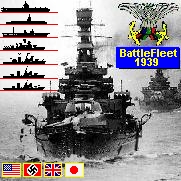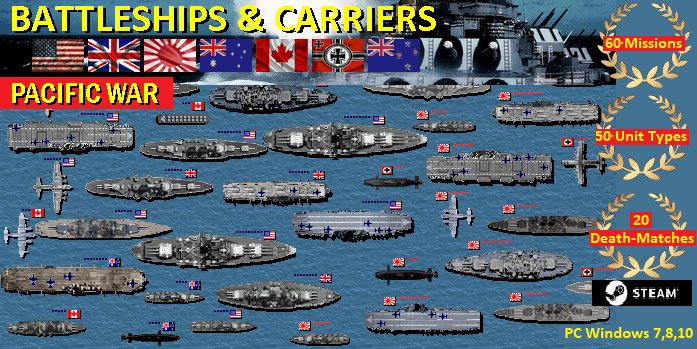WW1 World War 1
1914-1918
Battle of Gallipoli
Battle of Port
Arthur
Battle of Jutland
Skagerrak
WW2 Timeline
List of wars
Third Reich
Organization and people
GERMAN ARMY WW2
ORDER OF BATTLE
Adolf (Adolph)
Hitler WW2
Axis Powers WW2
Pact of Steel
Gestapo
Battleship Game - WW2 Naval
Strategy: the best choice among aircraft carrier games and battleship games.
Missions and Scenarios:
Pearl Harbor Game
Atlantic Game 1943
Sink Cruisers Game
Midway Game
Iwo Jima Game
US Marines Game
Luftwaffe Game Pacific
Torpedo Game Boats
Bismarck Game Pacific
Destroy RAF Game
Okinawa
Us Navy Submarine Game
Fleet Submarines Game
Kamikaze Game
U Boat Game
Singapore Game
Swordfish Hunt
Patrol Boats
Air Supremacy
Alert
Battleships Game
Java
Defense
Fleet Cruisers Game
Atlantic Island
Coral Sea Game
Iron Sea
Mykonos
Imperial Ocean
Long Convoy
Skagerrak
Target Los Angeles
West Pacific Game
Pacific War Game
Leyte Transport
Emperor Hirohito
Normandy Game
South Pacific Game
Destroy USAF Game
Submarine Games
US Navy Game
Free Hunt Doenitz Game
Free Hunt Spruance Game
Free Hunt Halsey Game
Imperial Navy I
Royal Navy Game
Free Hunt Pearl Harbor Games
Midway II
Kriegsmarine I
Brisbane Convoy
Clear West Coast
Fall Of Australia
Battle For Leyte
Conquer Of Japan
HMAS Perth
Road To Okinawa
Orange Ports
Emperor Defense
Prince Of Wales
San Bernardino
Pacific Race
Heavy Duty
Tokio Express
Operation Sidney
Bomber Operation
Conquer Of Italy
Heavy Cruiser Game
Frigate Hunt
Santa Cruz
Lamansh Game
Azores Transport
Norway Convoy
Invasion
Grossadmiral
Norway Ports
Drang Nach Ost
Convoy Pk30
Ciano Defense
Sir John Tovey
Free Hunt Andrews
Germans On Pacific
Silent Hunt
Antigua
Return To Midway
Kriegsmarine Game II
Royal Air Force Game
F. Hunt Lancaster
Jamamoto Game
Free Hunt USN
Free Hunt Japan
Free Hunt RAAF
Free Hunt U Boat Game
Free Hunt Aircraft Carriers Game
Free Hunt Hawaii
Free Hunt Yamato Game
Free Hunt Iwo Jima Game
Free Hunt Pacific Game
Free Hunt Torpedos
Free Hunt Convoy
Free Hunt Germany
Free Hunt Germany II
Free Hunt Italy
Free Hunt Malaya
Free Hunt Subs Game
Free Hunt B-26 Game
Free Hunt USN 1944
Devil Island
Dragoon Carriers
|
Allies WW1 WW2
In general, allies are people or
groups that have joined an alliance. When spelt with a
capital A, Allies usually denotes the countries that
fought together against the Central Powers in World War I
and against the Axis powers in World War II.
Table of contents
1 World War I
1.1 Major Allies
1.2 Minor Allies
2 World War II
2.3 Major Allies
2.4 Minor Allies
2.5 Non-fighting ("moral support") Allies
WW1 - World
War I
Major Allies
France
United Kingdom
Russia (until 1917)
United States (from April 6, 1917)
(US President Woodrow Wilson and his administration was
however keen not to define USA as an allied. America
entered the war as an "associated power" rather
than as an ally of France and Britain, and maintained
that distance through the war and the Paris Peace
Conference, 1919.)
WW1 Minor Allies
Australia
Belgium
Canada
Japan
Greece
Italy (from May 23, 1915)
Montenegro
Newfoundland
New Zealand
Romania
Serbia
South Africa
WW2 - World
War II
After Nazi-Germany in March 1939 had occupied the remains
of Czechoslovakia, the British ambassador was recalled
from Berlin and Neville Chamberlain declared that if
Hitler attacked Poland, considered next in turn for an
assault by the Third Reich, then the UK and France would
give Poland "all support in their power", a
promise soon also given to Greece and Romania after
Italy's conquest of Albania on April 7, 1939.
A formal military alliance was concluded between the UK,
France and Poland on April 6th, 1939, whereafter also the
Soviet Union initiated alliance negotiations, although
unsuccessfully. The Soviet Union would instead agree with
Nazi-Germany in the Molotov-Ribbentrop Pact of August
1939.
The dates given below are for entry into the war.
| CIA / KGB intelligence game. Run your own operation game.
Travel around the world and set up espionage
game, trade with state secrets, weapon systems,
spy codes, WMD, hire secretaries, agents, lawyers
and soldiers, establish secret agent stations,
cells and bases and search for criminals and
politicians. Involve in agent game. Game contains
more than 40 missions including Nuclear Game,
Cold War Game, Secret Agent, CIA Games, USAF,
Prime Minister, RAF, Bin Laden, Sadam, KGB,
Operations Iran… |
|
WW2 Major Allies
(later: permanent members of the UN Security Council)
China
France (3 September 1939) - then (after 1940) Free France
United Kingdom (3 September 1939)
Soviet Union (from 22 June 1941)
United States (from 7 December 1941)
WW2 Minor Allies
Australia
Belgium (invaded May 10, 1940)
Brazil
Canada (10 September 1939)
Greece (invaded October 28, 1940)
Holland (invaded May 10, 1940)
Luxembourg
New Zealand
Norway (invaded April 9, 1940)
Poland (invaded 1 September 1939)
South Africa
Yugoslavia
British, Dutch and French colonies fought alongside their
parent countries. Most countries occupied by Nazi Germany
continued to fight as governments in exile.
WW1 Allies
The Allies of World War I, or Entente Powers, were the
countries that opposed the Central Powers in the First
World War.
The members of the original Triple Entente of 1907 were
the French Republic, the British Empire and the Russian
Empire. Italy ended its alliance with the Central Powers,
arguing that Germany and Austria-Hungary started the war
without prior consultation with all allies and that the
alliance was only defensive in nature; it entered the war
on the side of the Entente in 1915. Japan was another
important member. Belgium, Serbia, Greece, Montenegro and
Romania[2] were affiliated members of the Entente.
The 1920 Treaty of S�vres defines the Principal Allied
Powers as the British Empire, French Republic, Italy and
Japan. The Allied Powers comprised, together with the
Principal Allied Powers, Armenia, Belgium, Greece, Hejaz,
Poland, Portugal, Romania, the Serb-Croat-Slovene state
and Czechoslovakia.
The U.S. declaration of war on Germany, on 6 April 1917
was on the grounds that Germany had violated its
neutrality by attacking international shipping,
sabotaging munitions on American soil and the Zimmermann
Telegram sent to Mexico. It declared war on
Austria-Hungary in December 1917. The U.S. entered the
war as an "associated power", rather than as a
formal ally of France and the United Kingdom, in order to
avoid "foreign entanglements".[8] Although the
Ottoman Empire and Bulgaria severed relations with the
United States, neither declared war.
The Dominions and Crown Colonies of the British Empire
made great contributions to the Allied war effort, but
did not have independent foreign policies in World War I
with the British War Cabinet exercising operational
control of British Empire forces. The Dominion
governments did control recruiting, and removed personnel
from front-line duties as they saw fit. From early 1917,
the War Cabinet was superseded by the Imperial War
Cabinet, which had Dominion representation. The
Australian Corps and Canadian Corps were placed under the
command of Australian and Canadian Lieutenant Generals
John Monash and Arthur Currie,[10] respectively, who
reported in turn to British generals.[citation needed] In
April 1918, operational control of all Entente forces on
the Western Front passed to the new supreme commander,
Ferdinand Foch of France.
Text is available
under the terms of the GNU Free Documentation License
|
Allies
in World War 1 and 2
In English usage, allies are those who share a
common goal and whose work toward that goal is
complementary may be viewed as allies for various
purposes even when no explicit agreement has been
worked out between them.
Similarly,
when the term Allies is used in the
context of war or armed struggle, a formal
military alliance is not required for being
perceived as an ally—co-belligerence, to
fight alongside someone, is enough. According to
this general usage, allies become allies not when
concluding an alliance treaty but when struck by
war.
The Allied Nations has been a name for a
few organisations and factions in popular media,
such as the Mercenaries games. The Allies in the
Command & Conquer: Red Alert series include
the nations of the World War II alliance plus
Germany, allied in the face of Soviet aggression
towards Europe.
|
|
| |
|
|
| |
 |
|
| |
 |
|
| |
Turn-based WW2
naval game, extension to the classic
Submarine game (Battleship game)
where ships/planes/subs can move. Contains plenty
of game missions, game campaigns and 40 ship,
submarine, airplane ana port artillery types,
with combat maps up to 96X96 large. |
|
| |
|
|
| |
|
|
| |
|
|
| |
|
|
| |
Guns Girls
Lawyers Spies is a trade management game.
You'll build your multinational spy company,
destroy competition, hire employees, spies, and
businessman, establish spy cells, bases and
objects.
There is a more than 40 missions with different
game objectives. |
|
| |
|
|
| |
|
|
| |
|
|
| |
Tycoon Strategy
Game - build your own world business empire as an
arms dealer tycoon. Travel around the world,
trade with more than 400 weapon systems, hire
secretaries, bodyguards, lawyers, fighters and
tanks, establish companies and search for
criminals and hostages. |
|
| |
|
|
|
